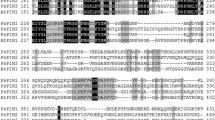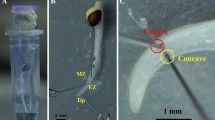Abstract
The transport of [14C]phenylacetic acid (PAA) in intact plants and stem segments of light-grown pea (Pisum sativum L. cv. Alderman) plants was investigated and compared with the transport of [14C]indiol-3yl-acetic acid (IAA). Although PAA was readily taken up by apical tissues, unlike IAA it did not undergo long-distance transport in the stem. The absence of PAA export from the apex was shown not to be the consequence of its failure to be taken up or of its metabolism. Only a weak diffusive movement of PAA was observed in isolated stem segments which readily transported IAA. When [1-14C]PAA was applied to a mature foliage leaf in light, only 5.4% of the 14C recovered in ethanol extracts (89.6% of applied 14C) had been exported from the leaf after 6.0 h. When applied to the corresponding leaf, [14C]sucrose was readily exported (46.4% of the total recovered ethanol-soluble 14C after 6.0 h). [1-14C]phenylacetic acid applied to the root system was readily taken up but, after 5.0 h, 99.3% of the recovered 14C was still in the root system.
When applied to the stem of intact plants (either in lanolin at 10 mg·g-1, or as a 10-4 M solution), unlabelled PAA blocked the transport through the stem of [1-14C]IAA applied to the apical bud, and caused IAA to accumulate in the PAA-treated region of the stem. Applications of PAA to the stem also inhibited the basipetal polar transport of [1-14C]IAA in isolated stem segments. These results are consistent with recent observations (C.F. Johnson and D.A. Morris, 1987, Planta 172, 400–407) that no carriers for PAA occur in the plasma membrane of the light-grown pea stem, but that PAA can inhibit the carrier-mediated efflux of IAA from cells. The possible functions of endogenous PAA are discussed and its is suggested that an important role of the compound may be to modulate the polar transport and-or accumulation by cells of IAA.
Similar content being viewed by others
Abbreviations
- IAA:
-
indol-3yl-acetic acid
- NPA:
-
N-1-naphthylphthalamic acid
- PAA:
-
phenylacetic acid
- IIBA:
-
2,3,5-triiodobenzoic acid
References
Eliezer, J., Morris, D.A. (1979) Effects of temperature and sink activity on the transport of 14C-labelled indol-3yl-acetic acid in the intact pea plant (Pisum sativum L.). Planta 147, 216–224
Goldsmith, M.H.M. (1977) The polar transport of auxin. Ann. Rev. Plant Physiol. 28, 439–478
Johnson, C.F., Morris, D.A. (1987) Regulation of auxin transport in the pea (Pisum sativum L.) by phenylacetic acid: Effects on the components of transmembrane transport of indol-3yl-acetic acid. Planta 172, 400–407
Katekar, G.F., Geissler, A.E. (1980) Auxin transport inhibitors. IV. Evidence of a common mode of action for a proposed class of auxin transport inhibitors: the phytotropins. Plant Physiol. 66, 1190–1195
Katekar, G.F., Geissler, A.E., Kennard, C.L., Smith, G. (1987) Recognition of phytotropins by the receptor for 1-N-naphthylphthalamic acid. Phytochemistry 26, 1257–1267
Katekar, G.F., Navé, J.-F., Geissler, A.E. (1981) Phytotropins. III. Naphthyphthalamic acid binding sites on maize coleoptile membranes as possible receptor sites for phytotropin action. Plant Physiol. 68, 1460–1464
Marigo, G., Boudet, A.M. (1977) Mélations polyphenols-croissance: Mise en evidence d'un éffet inhibiteur des composes phenoliques sur le transport polarisé de l'auxine. Physiol. Plant. 41, 197–202
Milborrow, B.V., Purse, J.G., Wightman, F. (1975) On the auxin activity of phenylacetic acid. Ann. Bot. 39, 1143–1146
Morris, D.A., Johnson, C.F. (1987) Characteristics and mechanism of long-distance auxin transport in intact plants. Acta Univ. Agric. Brno Fac. Agron., in press
Morris, D.A., Thomas, A.G. (1978) A microautoradiographic study of auxin transport in the stem of intact pea seedlings (Pisum sativum L.). J. Exp. Bot. 29, 147–157
Morris, D.A., Briant, R.E., Thomson, P.G. (1969) The transport and metabolism of 14C-labelled indoleacetic acid in intact pea seedlings. Planta 89, 178–197
Procházka, S., Černoch, V., Blažková, J., Dudelová, M. (1983) Morphoregulative effects of phenylacetic acid in pea seedings (Pisum sativum L.). Biochem. Physiol. Pflanz. 178, 493–501
Reichert, T.L., Peterson, W., Hertel, R. (1978) Two plant substances which inhibit respectively, auxin and naphthylphthalamic acid binding. (Abstr.) Plant Physiol. 61, Suppl., 64
Rider, G.A. (1982) An investigation of the fate of exogenous auxin in the pea, with special reference to the formation and role of auxin conjugates. Ph.D. thesis, University of Southampton, UK
Rubery, P.H. (1980) The mechanism of transmembrane auxin transport and its relation to the chemiosmotic hypothesis of the polar transport of auxin In: Plant growth substances 1979, pp. 50–60, Skoog, F., ed. Springer, Berlin Heidelberg New York
Rubery, P.H. (1986) The evolution of polar transport models, and some possiblilities for the regulation of auxin carriers. In: Plant growth substances 1985, pp. 197–202, Bopp, M., ed. Springer, Berlin Heidelberg New York
Schneider, E.A., Wightman, F. (1978) Auxin. In: Phytohormones and related compounds — a comprehensive treatise, vol. I, pp. 29–105, Letham, D.S., Goodwin, P.B., Higgins, J.T.V., eds. Elsevier/North Holland, Amsterdam Oxford New York
Schneider, E.A., Kazakoff, C.W., Wightman, F. (1985) Gas chromatography-mass spectrometry evidence for several endogenous auxins in pea seeding organs. Planta 165, 232–241
Suttle, J.C., Mansager, E.R. (1986) The physiological significance of phenylacetic acid in abscising cotton cotyledons. Plant Physiol. 81, 434–438
Thomson, K.S., Leopold, A.C. (1974) In vitro binding of morphactins and N-1-naphthylphthalamic acid in corn coleoptiles and their effects on auxin transport. Planta 115, 259–270
Trillmich, K., Michalke, W. (1979) Kinetic characterization of N-1-naphthylphthalamic acid binding sites from maize coleoptile homogenates. Planta 145,119–127
Wheeler, A.W. (1979) Auxin-like growth activity of phenylacetonitrile. Ann. Bot. 41, 867–872
Wightman, F. (1973) Biosynthesis of auxins in tomato shoots. Biochem. Soc. Symp. 38, 247–275
Wightman, F., Lighty, D.L. (1982) Identification of phenylacetic acid as a natural auxin in the shoots of higher plants. Physiol. Plant. 55, 17–24
Author information
Authors and Affiliations
Rights and permissions
About this article
Cite this article
Morris, D.A., Johnson, C.F. Regulation of auxin transport in pea (Pisum sativum L.) by phenylacetic acid: inhibition of polar auxin transport in intact plants and stem segments. Planta 172, 408–416 (1987). https://doi.org/10.1007/BF00398671
Received:
Accepted:
Issue Date:
DOI: https://doi.org/10.1007/BF00398671




